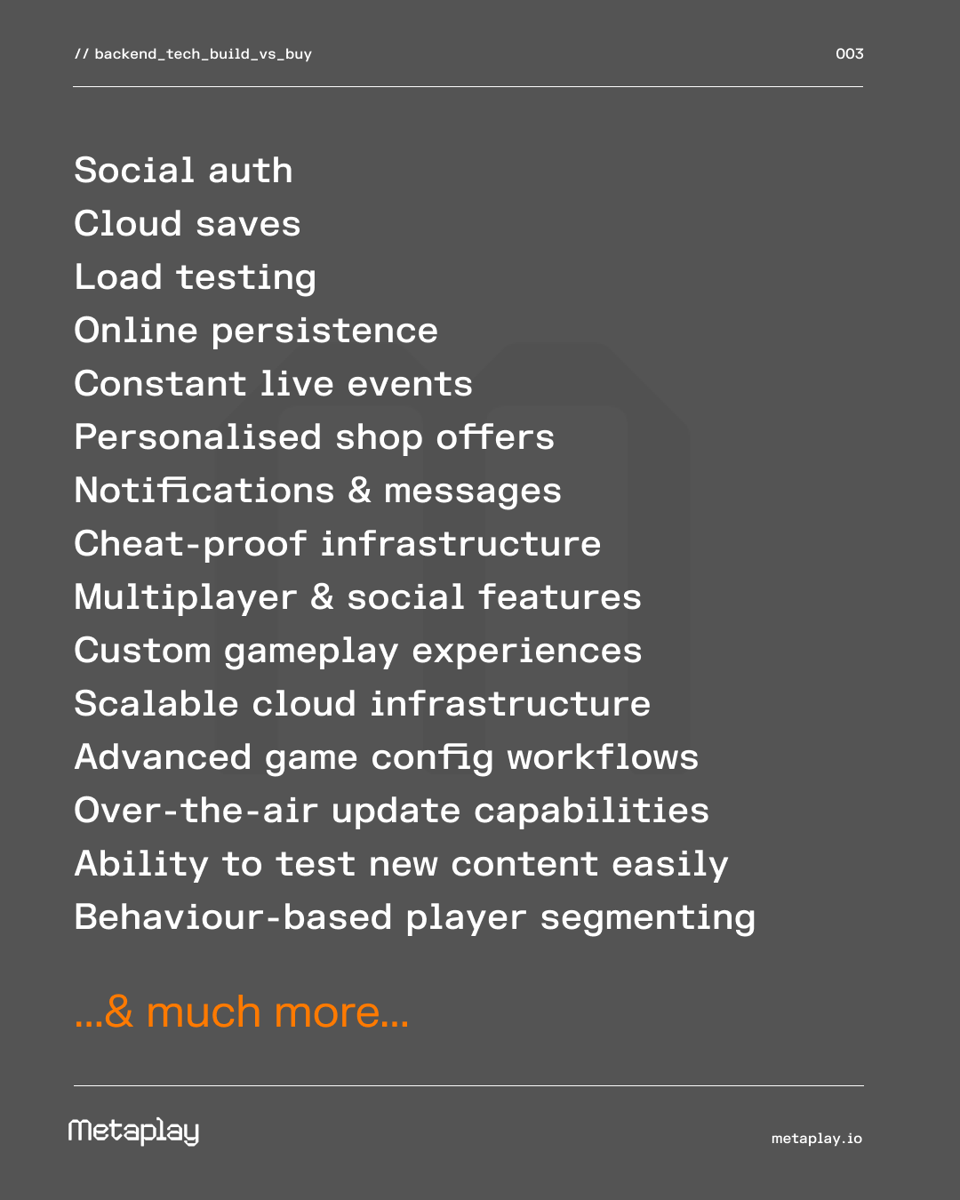.png)
Mobile game backend: Should you build or buy your tech?
.jpeg)
Chris Wilson •
All top-grossing games use bespoke backend tech. Should you build your own? Or use an external backend-as-a-service? Get the key arguments for and against each here.
What's behind a great mobile game?
All top-grossing mobile games use bespoke backend tech.
Why?
Because they need to fulfil all of the following functionalities:

Most of this can't be implemented with traditional off-the-shelf tools and tech.
So is it better to build your own backend? Or use a ready-made platform?
Let's take a look at the pros and cons of both building your own backend tech, or using a backend tech provider (i.e. backend-as-a-service, or BaaS as it's called in some quarters).
We'll weigh these up against the needs of feature-complete mobile games, and consider what the best option might be if you're looking to make a mobile game that'll break into the top of the charts.
Building your own game backend from scratch

The pros of building your own backend
Ownership and control
Building a backend in-house means your tech and tools will only ever be yours.
You’ll always be in full control, and your backend will become part of your studio’s core IP.
There are scenarios in which this can be advantageous. For example, if you are working with venture capitalists, business angels, private equity, or any other kind of early-stage funding (e.g. grants, loans etc.) do they require that you build your game on infrastructure that's legally yours?
It's unlikely, as most game studios' competitive advantage derives from the games they make, rather than the tech that supports them, but it's worth considering in any case.
Investors might also need to be reassured that your reliance on third parties is kept to an absolute minimum in order to minimise vendor risk as much as much as possible. This could be a reason why maintaining ownership and control of the entirety of your tech stack is advantageous.
Complete customization
When you’re building from scratch, it's easy to extend and customise your tools and tech, and tailor your backend to meet the specific needs of your game.
(Be warned that this is much easier said than done.)
But nevertheless, it's true. When your game's built on your own custom tech, you can add whatever you like, whenever you need to.
No third-party dependencies
Building your own game backend technology means you don't need to rely on external parties to ensure your game keeps on running.
We touched upon this above already, but that's got to be a plus point for business continuity, right?
If you're already a big enough team, you might find that having your game backend tech managed completely in-house can be easier, too. That's because communication stays in one place, even if it comes at cost of development speed and running a tech stack that lags behind the best in the market.
The cons of building your own backend
While building your own game backend technology does have advantages, there are some crucial downsides to consider that could massively impact your business and your capability to ship top-tier games, fast.
Here are three of them.
You need to hire and manage a team of specialist software developers
Specialist software developers are both expensive and hard to find.
Even when you do find them, it can be harder still to integrate them into your game development teams. This can lead you to lose focus on your actual game development.
You don't know what you need until you need it
We spend a lot of time talking about this here at Metaplay. But what does it mean exactly?
Not knowing what you need until you need it means that as your mobile game grows, your tech needs to evolve with it.
(Not just with it, in fact, but ahead of it.)
You're making games for the now, but you need to be sure that you have one eye on the future. In other words, while you're building for the short-term, you're planning for the long-term.
It's important to remember that your players are always going to be one step ahead of you. Competition in the Apple App Store and Google Play Store is intense, and with thousands of new games launching every month it's almost a certainty that whatever you're making, someone else is about to ship a near-carbon copy of.
If they can get ahead of you on execution speed and new feature development, you'll be stuck playing catch up.
Don't let your tech stack be the reason that happens to you.
Building a mobile game backend is hard
If you've built a mobile game backend before, you'll know there's far more to it than meets the eye.
If you haven't, then you'll just have to trust us (or ask another studio which has built one themselves.)
Let's take a deeper look.
Building your own backend: a brief summary
Building your own mobile game backend is a huge investment in time, effort, and energy.
But it does guarantee you the ownership, control, flexibility and extensibility you need to be able to make top-grossing games.
If you have the team size, the expertise, and the financial backing to make it happen, as well as the capacity to execute with speed and quality, then it's a smart move to build out your own game backend.
The problem?
Well, you're looking at a minimum of five highly-skilled (and very expensive) software development specialists just to get you started.
Once you've found them, they need to be integrated well-enough into the game development team that they can work almost in advance of them, ensuring that as new features and functionalities are added to the game and product roadmap, the technological infrastructure and game development plans are there already.
It's a tall order to execute, but done right, it pays off. It's how some of today's biggest studios have built some of the planet's greatest games.
But is it worth it? Well, it depends what the alternatives are.
We'll delve into that below, when we take a look at the pros and cons of using a backend-as-a-service provider for your mobile game.
Using a backend-as-a-service for your mobile game

Using a backend-as-a-service provider, instead of developing your own technology, can be an incredibly efficient and powerful way to build out your mobile game.
However, many traditional solutions lack the necessary capabilities to support a top 100 grossing game - so make sure you choose wisely.
The cons of traditional backend-as-a-service providers
Inflexibility
The traditional backend-as-a-service providers in mobile gaming are default choice for a reason: they're incredibly good at getting a game up-and-running, fast.
But what about after that? Once you've proven your game's concept, shipped it globally, and started running paid user acquisition and other marketing, how do you ship new features and functionalities that help your game stand out?
That's where most game studios that are using the default BaaS providers run into problems.
The vast majority of the tools on the market right now are rigid, inflexible, inextensible, and don't offer any customisation possibilities.
Though it's hard to see the potential implications of this in pre-production, soft-launch, or even in the immediate aftermath of global launch, once your game starts to scale it becomes a real problem.
Because adding new features becomes hard. Keeping up with your players becomes hard. Growth gives way to bottlenecks at almost every turn, and if you want to innovate on your game you're left with little choice other than to migrate it to an entirely new (and most of the time, custom-made) backend tech platform.
Cash commitment
Good tech and tools cost money.
(There just ain’t no way around that one, unfortunately.)
But you should still ask the question: Will investing in externally made game backend tech be more cost-effective than building a whole new team?
You'll probably find the answer is a resounding 'yes'.
Lack of ownership and control
Before you sign up to any third-party solution, consider whether not ‘owning’ the tech will cause a risk to your business.
We discussed this a little above too, but some strategic questions that you should think about when addressing the decision whether to build or buy your mobile game's backend technology are:
- Do your tools and tech need to become a core competency?
- Are you sacrificing a potential competitive advantage by not being the legal proprietor of your backend’s IP?
As mentioned above, most game studios’ competitive advantage derives from the games they make, rather than the tech that powers them, so this is unlikely. But it’s a point worth considering nonetheless.
You also need to be mindful that should anything happen to the tech provider, you’re protected - no matter what.
In the past, we've seen backend tech development companies acquired only to then be shut down barely a blink of an eye later.
It's understandable, then, that many game developers are hesitant about using a third-party backend tech provider for their mobile game. What if the same fate were to befall the provider they chose?
Transitioning away from a backend and migrating your entire game to another tech provider is a costly process.
However, these risks can be mitigated against. Make sure your BaaS provider can:
1. Guarantee you full access to the entirety of your game's codebase
2. Deploy your game's backend into your own cloud, rather than an anonymous third-party server
The pros of buying the right backend tech for your game
When chosen smartly, ready-made and purpose-built backend technology can propel your studio to the summit of the top-grossing mobile game charts.
Let's take a look at three of the top reasons why.
Build like the best
Some backends are limited. But with solutions like Metaplay, you’ll be guaranteeing yourself access to premium tools and tech, ready-made for making whatever you need, whenever you need it.
In short: you can enjoy the same robust functionalities of a top tier, internally built backend, at a fraction of the cost and with minimal time-consuming development.
Battle-tested and proven
Countless new game launches have been blighted by scaling issues.
It’s not uncommon for a hotly-anticipated new game to launch to a fanfare, only for everything to crash due to flaws in the game studio's in-house tech.
Metaplay's backend technology is trusted by top game developers like Metacore and Dodreams, supporting hundreds of millions of players.
Rest assured knowing that your tech foundations will be reliable and robust with the right BaaS provider.
Stay lean and focused
Choosing a mobile backend-as-a-service that's purpose built for supporting top tier games saves you all the time, money, and hassle you'd otherwise spend building out your own tech.
This means you and your team can remain fully focused on doing what you do best - making a hit game.
In-house backend tech vs. backend-as-a-service: The verdict
Now we've considered the pros and cons of building your own game backend technology against the advantages and disadvantages or using external, ready-made game backend tech, where do we stand? What's the right approach for your next mobile game?
Ultimately, the tech and tools you need depends on what kind of game you’re making.
If you’re going big, and aiming for the top of the charts, then you need the backend to match.
Using a backend-as-a-service provider that’s purpose-built for covering every step of live service game development is a surefire way to ship faster - and cheaper - than building your own backend.
But you need to be careful not to sacrifice four key elements of your game development capabilities:
- Extensibility
- Flexibility
- Ownership
- Control
Compromising on these could make your life as a game developer much more difficult later on (even if it means quick wins in the short term).
So if you’re in the market for backend tech, be sure that it guarantees you the same freedom, flexibility, ownership, and control you’d get from an in-house backend.
One way to do this is by going for a backend like Metaplay, which ships with source code, deployed into your own cloud.
This gives you full control of the codebase (so you can adapt it to your game’s needs) and minimises vendor risk (to guarantee business continuity).
There are many more points to consider, especially when you’re aiming to top the charts, but this is a good place to start.
Most backend tech platforms allow you to sample their tools and tech before you make a decision.
Try experimenting with sample projects on different platforms to get a first-hand feel for what will not only fit your needs now, but also later.
Be sure to draw up a robust set of evaluation criteria that considers your plans for liveops, game updates, growth, and scaling, as well as pre-production and proof-of-concept.
That way, you can rest assured that you’ll never get caught out later on down the line.
And you’ll give your new mobile game the best chance of achieving the success it deserves.


